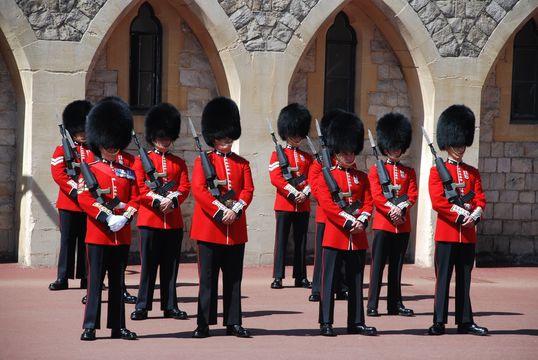
Chang of the Guard at Windsor Castle, in Sussex.HippoPx / CC
Five regiments of British Foot Guards have had the privilege of protecting King Charles III at her various castles and palaces: the Grenadier, Coldstream, Scots, Irish and Welsh Guards. These are the soldiers who get to wear those imposing bearskin hats.
With their typical love of understatement, the British Army actually refers to these huge hats as “caps.” They were first worn by British soldiers in 1815, following the defeat of Napoleon’s forces at the Battle of Waterloo. The 18-inch-high bearskins made the French grenadiers seem taller, more intimidating. To commemorate their victory, the British adopted similar hats for the soldiers who guard royal residences.
The standard bearskin cap of the Foot Guards is 18 inches, yet weighs just 1.5 pounds. That’s because the bearskin is stretched over a basket-like framework to which an adjustable leather skullcap and chin strap are attached for a secure fit. Wearers say the caps are quite comfortable, being both light and cool. However, they say the chin strap needs to be cinched rather tight and takes some getting used to.
The caps are made from the fur of Canadian black bears—one bear, one cap. Needless to say, this makes the animal rights folks in Britain unhappy, so the identity of the British company that makes them is a closely guarded secret.
Each bearskin pelt costs about £650. With care, a bearskin cap will last 80 years or more.
The British Army has tried various synthetic substitutes for the skins, but so far, the man-made fur caps lose their shape in strong winds and get waterlogged in heavy rains.
The Guards are members of the British Army who get 30 weeks of training, two weeks more than the regular infantry. The extra weeks are devoted to drill and ceremonial protocol.
Finally, it’s not called a “busby,” contrary to what I was told by my dear departed Scottish grandmother. The hat is not called a “Busby,” which is a much smaller hat (various dictionaries make the same error).
An interesting U.S. connection to the thoroughly British hats: The Liberty High School Grenadier Marching Band in Bethlehem, Pennsylvania, has a collection of about 80 bearskin caps. I contacted the band director, Kevin Long, who told me the following story.
Back in the 1960s when the band needed new uniforms, they decided to model their look on the British Coldstream Guards. There was a British ex-military man in the area who found out about this and offered to help them make their uniforms as authentic as possible. He put them in touch with British military surplus suppliers, and the band was able to purchase actual bearskin caps.
Fast forward to the 1970s. The Coldstream Guards Regimental Band was touring the U.S. Somehow, early in their trip, the caps were stolen or disappeared. No one knew for certain. Cue low-key British panic. They needed their bearskin caps! Someone had the idea of calling Liberty High School and asking if they might please borrow some bearskins for the rest of their tour Of course, the school agreed. The tour was a smashing success, and when the caps were returned, the school received twice as many as they had loaned.
Seventy-year-old British military surplus bearskin caps continue to be worn at Friday night football games in Bethlehem.
Visit the guard's museum
The Guards Museum is a secret treasure, located near Buckingham Palace, between Wellington Barracks and Birdcage Walk. The museum has colorful exhibits and a wealth of information. You can even dress up in a Foot Guard’s uniform—including the bearskin cap!
The museum includes The Toy Soldier Centre and The Guards’ Chapel. The Toy Soldier Centre has lead soldiers set up in realistic displays, with many of the items for sale. The lovely Guards’ Chapel is open to the public every day. There are beautiful Anglican services here on Sundays with a professional choir and splendid military musicians.
* Originally published in Jan / Feb 2018, updated 2023.





Comments